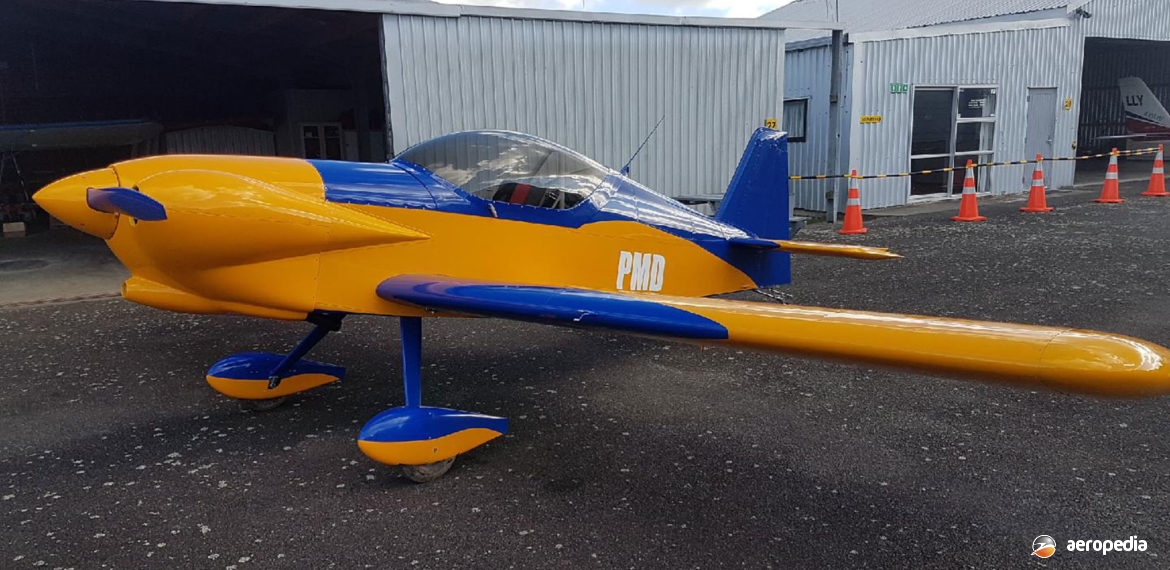Photograph:
New Zealand’s first Panther ZK-PMD (c/n 0044) at Stratford, New Zealand in 2017 (Stratford Aero Club)
Country of origin:
United States of America
Description:
Single-seat light sport monoplane
Power Plant:
One 75 kw (100 hp) Chevrolet Corvair (3000 cc) six-cylinder horizontally-opposed air-cooled engine
Specifications:
- Wingspan: 7.16 m (23 ft 5 in)
- Wing area: 8.63 m² (93 sq ft)
- Never exceed speed: 322 km/h (200 mph)
- Cruising speed at 2,438 m (8,000 ft): 266 km/h (165 mph)
- Stalling speed clean: 82 km/h (51 mph)
- Stalling speed in landing configuration: 74 km/h (46 mph)
- Take-off distance to 15 m (50 ft): 305 m (1,000 ft)
- Landing distance from 15 m (50 ft): 366 m (1,200 ft)
- G limits: +6 / -4.4 G
- Fuel capacity: 102 litres (22.4 Imp gals)
- Empty weight: 295 kg (650 lb)
- Loaded weight: 522 kg (1,150 lb)
History:
The Panther was designed by Daniel Weseman of Florida, USA, a pilot and machinist, who was involved in making conversions of the General Motors Corvair six-cylinder engine for installation in light aircraft. Based in Florida he designed and built the prototype of the Panther, a single-seat light sporting aircraft which fell within the LSA parameters under US regulations. The prototype was fitted with a 75 kw (100 hp) Corvair conversion, this being a Chevrolet motor vehicle air-cooled engine that had been modified with a new crankshaft and an extra fifth main bearing , the engine being mounted back-to-front so what was the transmission end of the car was now forward and supported the propeller. The extra bearing took the load off the propeller. It was fitted with an alternator at the end of the driveshaft, an aircraft updraft carburettor and a custom-built manifold.
The aircraft was constructed of metal with 6061 aluminium with flush blind rivets (although solid rivets were optional). It had 4130 steel tube construction from the seat back to the firewall, all critical attachment points being welded. It was covered with aluminium sheet.
The aircraft was described as a mid-sized single-seat low-wing sport aerobatic machine which could be built from a kit and was usually fitted with folding wings which could be quickly folded with no controls to disconnect. It was considered to be a new-generation kit featuring CAD-design parts that fitted together with ease. Skins were pre-punched to allow match-drilling to ribs. The canopy was described as a large tip-over unit. A baggage area was built into the rear of the cockpit, and the aircraft could be fitted with a ballistic parachute.
The aircraft could be fitted with the Corvair engine driving a Sensenich two-blade propeller but other engines which could be installed have been the Lycoming O-235, the Lycoming O-320 [with which it is known as the Panther Sport], Continental C-85, Continental O-200, UL Power, Jabiru 3300, and other engines ranging in power from 60 kw to 119 kw (80 hp to 160 hp).
First example of the type registered in this part of the world was ZK-PMD² (c/n 0044) built by Mark Dean of Palmerston North, NZ, this aircraft with a max weight of 521 kg (1,149 lb) meeting New Zealand Microlight Class 1 regulations and being powered by a Lycoming O-320 engine.

